Practice Question - 66 (Data Change over a Period of Time) | 100 DILR Questions for CAT Preparation PDF Download
There are 21 employees working in a division, out of whom 10 are special-skilled employees (SE) and the remaining are regular-skilled employees (RE). During the next five months, the division has to complete five projects every month. Out of the 25 projects, 5 projects are "challenging", while the remaining ones are "standard". Each of the challenging projects has to be completed in different months. Every month, five teams — T1 T2, T3, T4 and T5, work on one project each. T1, T2, T3, T4 and T5 are allotted the challenging project in the first, second, third, fourth and fifth month, respectively. The team assigned the challenging project has one more employee than the rest.
In the first month, T1 has one more SE than T2, T2 has one more SE than T3, T 3 has one more SE than T4, and T4 has one more SE than T5. Between two successive months, the composition of the teams changes as follows:
a. The team allotted the challenging project, gets two SE from the team which was allotted the challenging project in the previous month. In exchange, one RE is shifted from the former team to the latter team.
b. After the above exchange, if T1 has any SE and T5 has any RE, then one SE is shifted from T1 to T5, and one RE is shifted from T5 to T1. Also, if T2 has any SE and T4 has any RE, then one SE is shifted from T2 to T4, and one RE is shifted from T4 to T2.
Each standard project has a total of 100 credit points, while each challenging project has 200 credit points. The credit points are equally shared between the employees included in that team.
Q1: The number of times in which the composition of team T2 and the number of times in which composition of team T4 remained unchanged in two successive months are:
(a) (2,1)
(b) (1,0)
(c) (0,0)
(d) (1,1)
 View Answer
View Answer 
The table looks like this in Month 1.
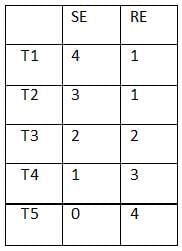
Table in month 2. (after exchanging employees according to conditions)
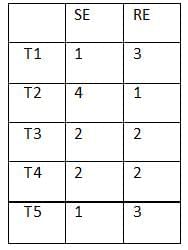
Table in month 3.
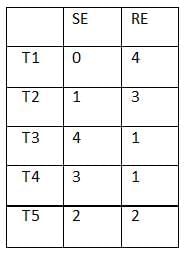
Table in month 4.
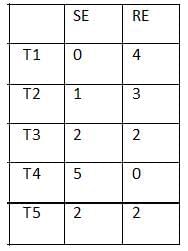
Table in month 5.
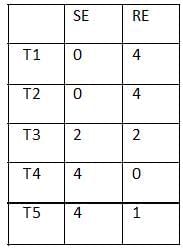
T2 remained unchanged in Month 3 and Month 4, and composition of T4 was never unchanged. Hence (1,0)
(0,2)
(0,3)
(1,2)
(1,3)
 View Answer
View Answer 
The table looks like this in Month 1.
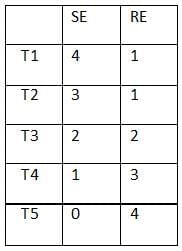
Table in month 2. (after exchanging employees according to conditions)
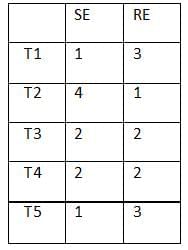
Table in month 3.
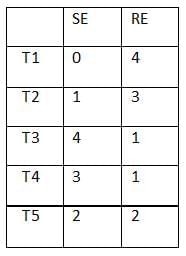
Table in month 4.
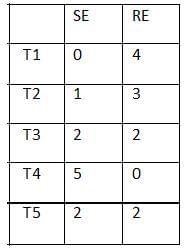
Table in month 5.
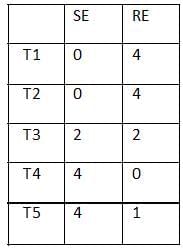
Refer to table of Month 3, the number of SE employees in T1 and T5 are respectively (0,2)
(a) 140
(b) 150
(c) 170
(d) 200
 View Answer
View Answer 
When challenging project is given, each employee gets 40 points.
When standard project is given, each employee gets 25 points.
Suppose:
If a particular employee is involved in all standard projects then his credit points will be: 125
If a particular employee is involved in 4 standard projects and 1 challenging project then his credit points will be: 140
If a particular employee is involved in 3 standard projects and 2 challenging projects then his credit points will be: 155
If a particular employee is involved in 2 standard projects and 3 challenging projects then his credit points will be: 170
If a particular employee is involved in 1 standard project and 4 challenging projects then his credit points will be: 185
If a particular employee is all challenging projects then his credit points will be: 200
Hence, an employee cannot earn 150 points.
(a) Aneek worked only in teams T1, T2, T3, and T4.
(b) Aneek worked only in teams T1,T2, T4, and T5.
(c) Aneek worked only in teams T2,T3, T4, and T5.
(d) Aneek worked only in teams T1,T3, T4, and T5.
 View Answer
View Answer 
Check option (a),
It is possible to move to T2 after working in T1 for the first month. From T2, either movement to T3 or T4 is possible. If moved to T3, then in next month he can move to T4, because of challenging project. Hence this option can be true.
Check option (b),
It is possible to move to T2 after working in T1 for the first month. From T2, either movement to T3 or T4 is possible. If moved to T4, next movement can be in T5. Hence this option can be true.
Check option (c),
T2, T3, T4, T5. This sequential movement is also possible.
Check option (d),
If Aneek is there in T1 for the first month, then he will shift to T2, T5 or remain in T1 in the subsequent month.
Consider he remained in T1, then he will either move to T5 or remain in T1. So, if this happens the sequence given in option can never follow.
Suppose he has shifted to T2, but T2 is not mentioned in option, so ruled out.
And if he moved to T5, in the next month then he will remain there only.
Hence option (d) is not correct.
|
102 videos|123 docs|121 tests
|
FAQs on Practice Question - 66 (Data Change over a Period of Time) - 100 DILR Questions for CAT Preparation
| 1. What strategies can be employed to analyze data changes over a period of time effectively? |  |
| 2. How can one identify the significance of changes in data over time? |  |
| 3. What types of data are most commonly analyzed for changes over time? |  |
| 4. Why is it important to consider the context when analyzing data changes over time? |  |
| 5. What role does technology play in tracking and analyzing data changes over time? |  |















